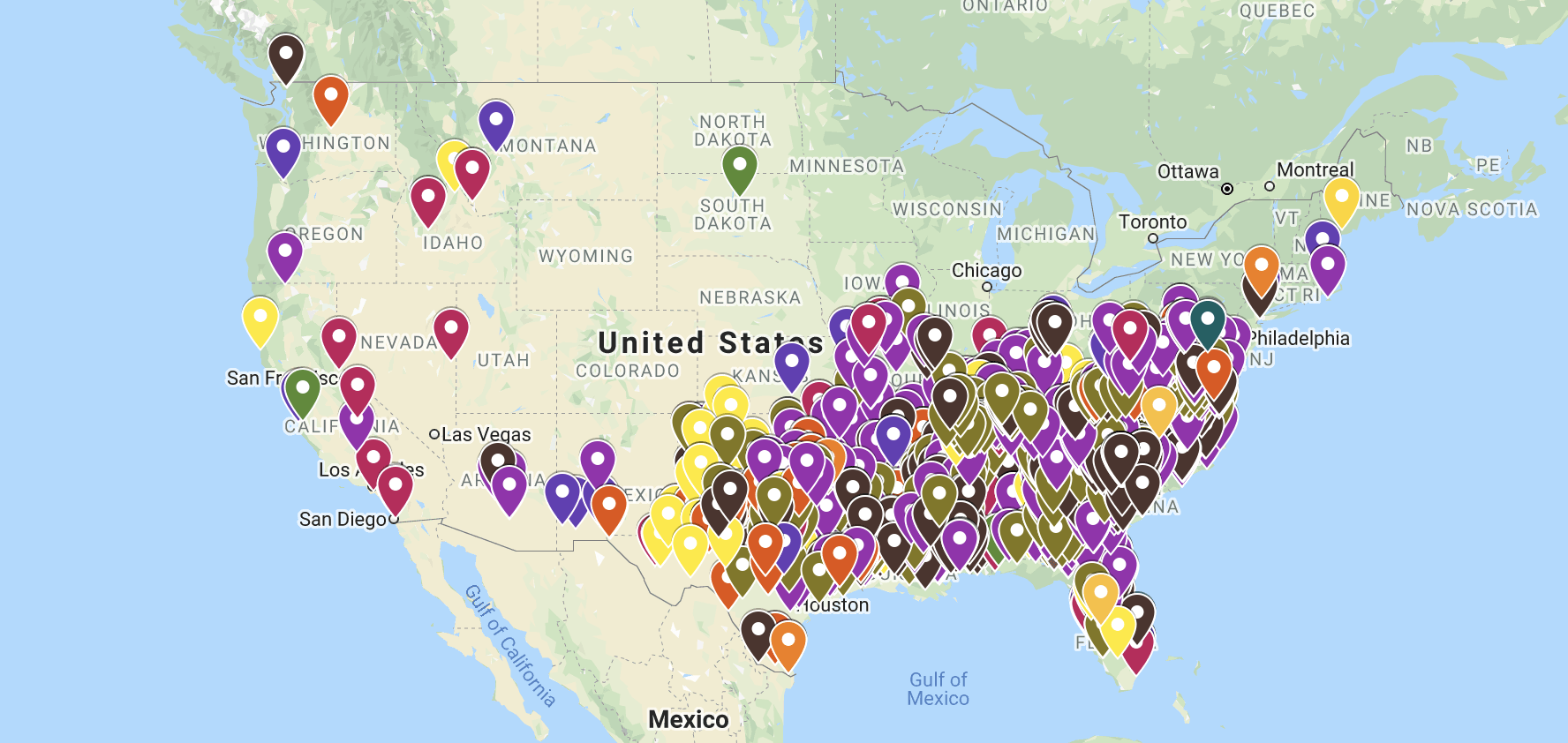The Southern Poverty Law Center has updated their 2016
report Whose Heritage?, to include and identify a map of 114 Confederate
symbols that have since been removed, along with the 1,747 that still stand.
"The Civil War ended 154 years ago. The Confederacy, as
former New Orleans Mayor Mitch Landrieu has said, was on the wrong side of
humanity," the report reads. "Our public entities should no longer play a role
in distorting history by honoring a secessionist government that waged war
against the United States to preserve white supremacy and the enslavement of
millions of people."
The map provides a visual for the locations of these public
symbols of the Confederacy, which are unsurprisingly very concentrated in the
American South. The symbols include removed, renamed, pending, and relocated
monuments, courthouse grounds, roads, parks/trails, schools, flags, buildings,
government office grounds, holidays, counties/municipalities, and scholarship.
The study concluded that there are 103 public K - 12 schools
and three colleges named after prominent Confederates. While Georgia (with 114
Confederate monuments), Virginia (110), and North Carolina (97) have more
Confederate monuments than others, Louisiana still has 32. The military base
Fort Polk in Louisiana was named in honor of Leonidas Polk, an Episcopal
bishop, slaveowner, and a Confederate general.
"We are forcing our black soldiers to serve on a base named
after leaders who served to keep them in chains," Iraq War veteran Fred Wellman
told Vox.com. Many view the naming of
schools after Confederate leaders in a similar vein, inappropriately promoting
the white supremacist values that damage black and minority students. In the
same way, having Confederate monuments in government spaces, public places, and
other forms dangerously upholds the values of the Confederacy and disrespects
and damages black and minority citizens.
The removal of Confederate monuments in the United States has become a hot button for some, who believe the symbols should be preserved as a reminder of the country's historical past. However, many Americans recognize the immorality of the colonialists, slaveowners, and anti-abolitionists and the way that statues honoring these figures actually promote dangerous ethics and values of racism and white supremacy.

In the wake of the police killings of George Floyd, Breonna
Taylor, and many other black Americans, many have found it impossible to
reconcile the continued existence of such public statues and monuments that
represent racism in the United States. Protestors have called for the removal
of these symbols of the Confederacy, with some people even taking action into
their own hands.
In New Orleans, the grassroots organization Take Em Down Nola, which removed
the Robert E. Lee Statue from Lee Square in 2017, along with other Confederate
symbols, assisted the people of New Orleans in removing the bust of slaveowner
John McDonogh on June 13, 2020. The organization's website includes a list of
13 parks, six schools, and a vast list of streets, all named after white
supremacists. The organization's website also lists 12 remaining white supremacist
monuments in New Orleans yet to be removed, including the bust of Confederate
Colonel Charles Didier, Jefferson Davis Death Place Market, and the Sophie B.
Wright Statue. Another is the Andrew Jackson Monument in Jackson Square,
commemorating the slaveowner and perpetrator of genocide against Indigenous
people, which protestors were halted in their efforts to bring down on the
Friday of the 7 Days of Action.
"Although we fight for ALL symbols to white supremacy to be
removed from the landscape of New Orleans, we do so as a necessary step in the
direction of racial and economic justice," the organization said. "Just as
we need the symbols of oppression to be removed in the form of street names and
monuments, we simultaneously need the system to change by radically improving
the material conditions of everyday life for black children and families."
Scrolling through the different symbols in Louisiana, from
New Orleans's Robert E. Lee Boulevard to Plaquemine's Confederate memorial to
the Sons of Confederate Veterans commemorative license plate in Baton Rouge,
truly showcases how deeply entrenched the celebration and remembrance of
Confederate history is in the United States, despite the damage that history
causes. The names of buildings and institutions, statues people walk past, and
street signs are already so embedded in our society that it's difficult for
some people to realize the historical roots and how offensive they can be.
Just last week, Baton Rouge activist Gary Chambers
successfully debated the renaming of Lee High School, which will be taken up by
the School Board and its committee, and pointed out that Nicholls State
University is named after former brigadier general of the Confederacy, Francis
T. Nicholls. New Orleans has its own celebration of Nicholls, the conservative
Louisiana governor who saw the antebellum slavery period as the golden age,
with Governor Nicholls Street.
There is still so much that the government, society, and the
people must do to end police brutality and white supremacy, and to come to
terms with this country's history of racism. However, perusing this map
to identify the public symbols of the Confederacy in your own hometown or
neighborhood may assist you to be more conscious of the immoral history that
continues to be honored and to therefore fight against it.

